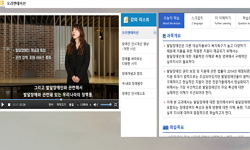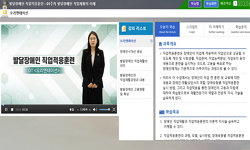The purpose of this study was to investigate the social status of college students with developmental disabilities through peer nomination and social network analysis, to compare the behavioral characteristics between preferred students and rejected s...
http://chineseinput.net/에서 pinyin(병음)방식으로 중국어를 변환할 수 있습니다.
변환된 중국어를 복사하여 사용하시면 됩니다.
- 中文 을 입력하시려면 zhongwen을 입력하시고 space를누르시면됩니다.
- 北京 을 입력하시려면 beijing을 입력하시고 space를 누르시면 됩니다.

또래지명법 및 사회연결망을 활용한 발달장애대학생의 사회적 지위 분석 = The Analysis on Social Status of College Students with Developmental Disabilities through Peer Nomination and Social Network preferred students and rejected students
한글로보기https://www.riss.kr/link?id=A101246608
- 저자
- 발행기관
- 학술지명
- 권호사항
-
발행연도
2012
-
작성언어
-
- 주제어
-
KDC
300
-
등재정보
KCI등재
-
자료형태
학술저널
- 발행기관 URL
-
수록면
27-54(28쪽)
-
KCI 피인용횟수
11
- 제공처
-
0
상세조회 -
0
다운로드
부가정보
다국어 초록 (Multilingual Abstract)
The purpose of this study was to investigate the social status of college students with developmental disabilities through peer nomination and social network analysis, to compare the behavioral characteristics between preferred students and rejected students. The participants of the current study were 19 college students with developmental disabilities in non-inclusive environment, 2nd grade in N university. The finding of this study is as follows. First, they are composed of groups characterized by popular, rejected, neglected, controversial, average sociometry status. Second, The popular student tend to show good appearance, regards for others, kindness, cooperation and high academic performance. on the other hand, the rejected students show unclean looking, unexpected behavior, ignore others, telling a lie, class disturbance and low academic performance. The findings further suggest the continuous monitoring on the social status of college students with developmental disabilities, the comprehensive and systematic educational activity for facilitating preferred students and compensating rejected students.
참고문헌 (Reference)
1 김은영, "평생교육조직 특성과 네트워크 수준이 조직효과성에 미치는 영향" 대구대학교 대학원 2011
2 문선영, "특수학급 장애학생의 교우 선호 경향에 대한 연구" 한국특수아동학회 10 (10): 63-87, 2008
3 강정수, "초등학교에서 특수 아동의 또래 관계 연구" 대구대학교 특수교육대학원 2006
4 이규경, "초등학교 학습부진아의 교우관계 특성" 한국학습장애학회 7 (7): 47-67, 2010
5 이세환, "초등학교 태권도 수련생의교우관계에 대한 사회연결망 분석" 한국스포츠사회학회 21 (21): 553-577, 2008
6 김대룡, "직업적응 중심의 교양영어 수업이 발달장애 대학생의 직업준비에 미치는 영향" 단국대학교 대학원 2012
7 김대룡, "직업 적응중심의 교양영어 수업이 발달장애대학생의 직업준비에 미치는 영향" 한국지적장애교육학회 14 (14): 75-102, 2012
8 변찬석, "일반학급에서의 경도장애아의 사회적 수용도" 22 : 77-98, 1998
9 변찬석, "일반학급에서의 경도장애아의 사회적 수용도" 5 : 69-84, 1998
10 서경희, "일반학급에 통합된 장애아동의 의로움, 사회적 불안, 우울" 22 : 77-98, 1999
1 김은영, "평생교육조직 특성과 네트워크 수준이 조직효과성에 미치는 영향" 대구대학교 대학원 2011
2 문선영, "특수학급 장애학생의 교우 선호 경향에 대한 연구" 한국특수아동학회 10 (10): 63-87, 2008
3 강정수, "초등학교에서 특수 아동의 또래 관계 연구" 대구대학교 특수교육대학원 2006
4 이규경, "초등학교 학습부진아의 교우관계 특성" 한국학습장애학회 7 (7): 47-67, 2010
5 이세환, "초등학교 태권도 수련생의교우관계에 대한 사회연결망 분석" 한국스포츠사회학회 21 (21): 553-577, 2008
6 김대룡, "직업적응 중심의 교양영어 수업이 발달장애 대학생의 직업준비에 미치는 영향" 단국대학교 대학원 2012
7 김대룡, "직업 적응중심의 교양영어 수업이 발달장애대학생의 직업준비에 미치는 영향" 한국지적장애교육학회 14 (14): 75-102, 2012
8 변찬석, "일반학급에서의 경도장애아의 사회적 수용도" 22 : 77-98, 1998
9 변찬석, "일반학급에서의 경도장애아의 사회적 수용도" 5 : 69-84, 1998
10 서경희, "일반학급에 통합된 장애아동의 의로움, 사회적 불안, 우울" 22 : 77-98, 1999
11 전정희, "일반학급에 통합된 장애아동의 또래관계 연구" 4 : 43-90, 1999
12 신경미, "일반학교와의 교류교육을 통한 우정지원프로그램 적용이 자폐아동과 일반아동간의 친구관계기술 습득에 미치는 효과" 한국특수교육문제연구소 3 (3): 107-134, 2002
13 강인설, "인기유아의 개인 특성과 사회적 네트워크와의 관계성 : 일반형 인기아와 양면형 인기아를 중심으로" 부산대학교 대학원 2011
14 마송희, "아동의 사회적 수용도에 관한 연구" 中央大學校 大學院 1991
15 임번장, "스포츠클럽 참가 아동의 또래관계 연결망 구조와 또래지위 결정 요인 분석" 한국스포츠사회학회 24 (24): 41-62, 2011
16 김우성, "생활체육활동 참가 중학생의 교우관계에 대한 사회연결망 분석" 한국사회체육학회 (33) : 565-576, 2008
17 강성구, "생활도우미 활동이 장애학생에 대한 일반학생의 또래관계에 미치는 영향" 국립특수교육원 12 (12): 133-160, 2005
18 김용학, "사회연결망 분석" 박영사 2007
19 김대룡, "발달장애대학생의 진로태도와 자기결정기술, 사회성기술 및 대인관계기술 간의 상관관계" 한국특수교육문제연구소 13 (13): 79-104, 2012
20 김대룡, "발달장애 대학생의 직업전환을 위한 진로태도 분석" 한국지적장애교육학회 13 (13): 133-152, 2011
21 오선영, "또래지원망 프로그램이 장애아동과 일반아동의 친구관계에 미치는 영향" 이화여자대학교 교육대학원 2000
22 서경희, "또래관계 중심 중재가 ADHD 아동의 우정 발달과 사회적 기술에 미치는 영향: 질적·양적 연구" 한국정서·행동장애아교육학회 26 (26): 43-64, 2010
23 최연철, "또래관계 분석방법 비교: 또래지명법, 또래평정법과 사회연결망분석을 중심으로" 한국영유아교원교육학회 16 (16): 291-317, 2012
24 조용태, "또래 거부된 정신지체아동의 행동특성" 17 (17): 103-120, 1996
25 金成元, "국민학교 아동의 교우관계 형성요인에 관한 연구" 韓國敎員大學校 大學院 1994
26 Dion, K. K., "Young children’s stereotyping of facial attractiveness" 9 : 183-198, 1973
27 Taylor, A. R., "The social adaptation of mainstreamed mildly retarded children" 58 : 1321-1334, 1987
28 Parkhurst, J. T., "Sociometric popularity and peer-received" 9 : 409-420, 1998
29 Roff, M., "Social adjustment and personality development in childhood" University of Minnesota Press 1972
30 Wasserman, S., "Social Network Analysis: Methods and Application" Cambridge University Press 1994
31 Asher, S. R., "Recent advances in the study of peer rejection, In Peer rejection in childhood" Cambridge University Press 3-14, 1990
32 McMichael, P., "Reading difficulties, behavior, and social status" 72 : 76-86, 1980
33 Straus, C. C., "Psychosocial impairment associated with anxiety in children" 16 : 235-239, 1987
34 Parker, J. G., "Peer relations and later personal adjustment: Are low-accepted children at risk?" 102 : 357-389, 1987
35 Hartup, W. W., "Peer relation, In Handbook of Child Psychology(Vol. Ⅳ): Socialization, Personality, and Social Development" Wiley & Sons 103-196, 1983
36 W. W. Hartup, "Peer relation, In Handbook of Child Psychology(Vol Ⅳ): Socialization, Personality, and Social Development" John Wiley & Sons 135-,
37 Guralnick, M. J., "Peer interactions in mainstreamed and specialized classrooms : A comparative analysis" 54 : 415-425, 1988
38 Howes, C., "Peer interaction of young children" 53 : 1-94, 1988
39 Coie, J. D., "Peer group behavior and social status, In Peer Rejection in Childhood" Cambridge University Press 17-59, 1990
40 Wolfenberger, W., "PASSING" National Institute on Mental Retardation 1983
41 Emirbayer, M., "Network analysis, culture, and the problem of agency" 99 : 1411-1455, 1994
42 Knoke, D., "Network analysis" Sage 1981
43 Carrington, P., "Models and methods in social network analysis" Cambridge University Press 2005
44 Rubin, L., "Just Friends - The Role of Friendship in Out Lives" Harper and Row 1986
45 Ladd, G. W., "Having Friends, Keeping Friends, Making Friends and Being Liked by Peers in the Classroom: Predictors of Children’s Early School Adustment?" 61 (61): 1081-1100, 1990
46 Lerner, R. M., "Effects of age, sex, and physical attractiveness on child-peer relations, academic performance, and elementary school adjustment" 13 : 585-590, 1977
47 Coie, J. D., "Dimensions and types of social status : A cross-age perspective" 18 : 557-570, 1982
48 Rubin, K. H., "Concurrent and predictive correlates of sociometric status in kindergarten and grade 1 children" 29 : 337-351, 1983
49 Crick, N. R., "Children’s perceptions of their peer experiences : Attribution, loneliness, social anxiety, and social avoidance" 29 : 244-254, 1993
50 Asher, S. R., "Children’s loneliness : A comparison of rejected and neglected peer status" 53 : 500-505, 1985
51 Hartup, W. W., "Children’s friendships, In Current issues in autism: social behavior in autism" Plenum 61-79, 1986
52 Rabiner, D. L., "Children’s beliefs about familiar and unfamiliar peers in relation to their sociometric status" 29 : 236-243, 1993
53 Murray, C., "Children’s Relationships with Teachers and Bonds with School : An Investigation of Patterns and Correlates in Middle childhood" 38 : 423-445, 2000
54 Newcomb, A. F., "Children’s Peer Relations : A Mate-Average Revew of Popular, Rejected, Neglected, Controversal, Average Sociometric Status" 113 (113): 52-83, 1993
55 Bierman, K. L., "Characteristics of aggressiverejecter, ggressive(nonrejected), and rejected(nonaggressive)boy" 64 : 139-151, 1993
56 Adams, G. R., "An assessment of parents’ and teachers’ expectations of preschool children’s social preference for attractive or unattractive children and adults" 51 : 224-231, 1980
동일학술지(권/호) 다른 논문
-
초등학교 통합학급 교사들의 가족 및 전문가들과의 협력에 대한 인식과 실제
- 대구대학교 한국특수교육문제연구소
- 김태영 ( Taeyoung Kim )
- 2012
- KCI등재
-
- 대구대학교 한국특수교육문제연구소
- 남기현 ( Ki Hyun Nam )
- 2012
- KCI등재
-
학교-가정협력 통합발달 프로그램이 농중증,중복장애아의 의사소통 기술에 미치는 영향
- 대구대학교 한국특수교육문제연구소
- 박미정 ( Mee Jung Park )
- 2012
- KCI등재
-
고등학교 신설 특수학급 담당 교사들의 직무 경험에 관한 내러티브 탐구
- 대구대학교 한국특수교육문제연구소
- 김용욱 ( Yong Wook Kim )
- 2012
- KCI등재
분석정보
인용정보 인용지수 설명보기
학술지 이력
| 연월일 | 이력구분 | 이력상세 | 등재구분 |
|---|---|---|---|
| 2027 | 평가예정 | 재인증평가 신청대상 (재인증) | |
| 2021-01-01 | 평가 | 등재학술지 유지 (재인증) |  |
| 2018-01-01 | 평가 | 등재학술지 유지 (등재유지) |  |
| 2015-02-04 | 학회명변경 | 한글명 : 대구대학교 한국특수교육문제연구소 -> 한국특수교육문제연구소영문명 : Daegu University Research Institute of the Korea Special Education -> Research Institute of the Korea Special Education |  |
| 2015-01-01 | 평가 | 등재학술지 유지 (등재유지) |  |
| 2014-05-23 | 학회명변경 | 한글명 : 한국특수교육문제연구소 -> 대구대학교 한국특수교육문제연구소영문명 : Research Institute of the Korean Special Education -> Daegu University Research Institute of the Korea Special Education |  |
| 2011-01-01 | 평가 | 등재학술지 유지 (등재유지) |  |
| 2009-01-01 | 평가 | 등재학술지 유지 (등재유지) |  |
| 2006-08-16 | 학회명변경 | 한글명 : BK21특수교육교육연구단 -> 한국특수교육문제연구소영문명 : Bk21 Project Force Of Special Education -> Research Institute of the Korean Special Education |  |
| 2006-06-22 | 학술지명변경 | 한글명 : 특수교육저널: 이론과 실천 -> 특수교육저널:이론과 실천 |  |
| 2006-05-18 | 학회명변경 | 한글명 : BK21특수교육교육연구단 -> 대구대학교 대학원 특수교육학과영문명 : Bk21 Project Force Of Special Education -> Daegu University Graduate School of Special Education |  |
| 2006-01-01 | 평가 | 등재학술지 선정 (등재후보2차) |  |
| 2005-01-01 | 평가 | 등재후보 1차 PASS (등재후보1차) |  |
| 2003-01-01 | 평가 | 등재후보학술지 선정 (신규평가) |  |
학술지 인용정보
| 기준연도 | WOS-KCI 통합IF(2년) | KCIF(2년) | KCIF(3년) |
|---|---|---|---|
| 2016 | 1.33 | 1.33 | 1.26 |
| KCIF(4년) | KCIF(5년) | 중심성지수(3년) | 즉시성지수 |
| 1.18 | 1.18 | 1.518 | 0.46 |




 KCI
KCI KISS
KISS






